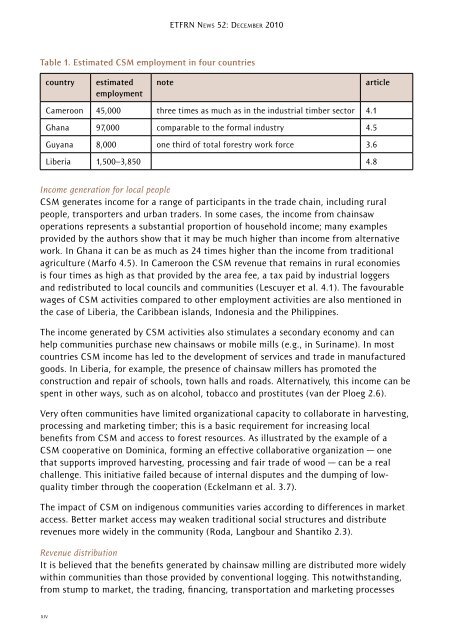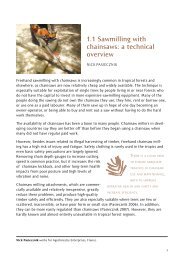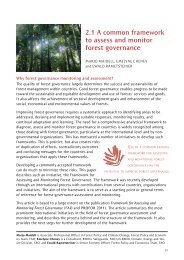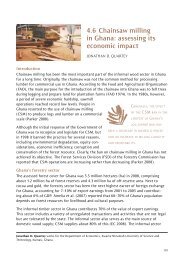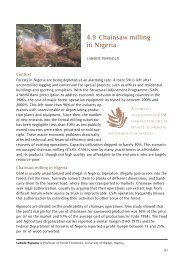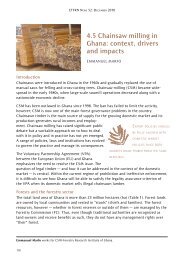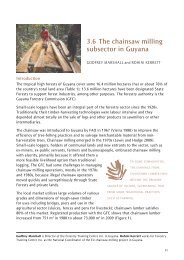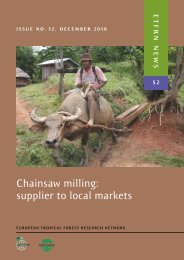Chainsaw milling: supplier to local markets - European Tropical ...
Chainsaw milling: supplier to local markets - European Tropical ...
Chainsaw milling: supplier to local markets - European Tropical ...
Create successful ePaper yourself
Turn your PDF publications into a flip-book with our unique Google optimized e-Paper software.
Table 1. Estimated csM employment in four countries<br />
country estimated<br />
employment<br />
ETFRN NEws 52: DEcEmbER 2010<br />
note article<br />
Cameroon 45,000 three times as much as in the industrial timber sec<strong>to</strong>r 4.1<br />
Ghana 97,000 comparable <strong>to</strong> the formal industry 4.5<br />
Guyana 8,000 one third of <strong>to</strong>tal forestry work force 3.6<br />
liberia 1,500–3,850 4.8<br />
Income generation for <strong>local</strong> people<br />
Csm generates income for a range of participants in the trade chain, including rural<br />
people, transporters and urban traders. in some cases, the income from chainsaw<br />
operations represents a substantial proportion of household income; many examples<br />
provided by the authors show that it may be much higher than income from alternative<br />
work. in Ghana it can be as much as 24 times higher than the income from traditional<br />
agriculture (marfo 4.5). in Cameroon the Csm revenue that remains in rural economies<br />
is four times as high as that provided by the area fee, a tax paid by industrial loggers<br />
and redistributed <strong>to</strong> <strong>local</strong> councils and communities (lescuyer et al. 4.1). The favourable<br />
wages of Csm activities compared <strong>to</strong> other employment activities are also mentioned in<br />
the case of liberia, the Caribbean islands, indonesia and the philippines.<br />
The income generated by Csm activities also stimulates a secondary economy and can<br />
help communities purchase new chainsaws or mobile mills (e.g., in suriname). in most<br />
countries Csm income has led <strong>to</strong> the development of services and trade in manufactured<br />
goods. in liberia, for example, the presence of chainsaw millers has promoted the<br />
construction and repair of schools, <strong>to</strong>wn halls and roads. alternatively, this income can be<br />
spent in other ways, such as on alcohol, <strong>to</strong>bacco and prostitutes (van der ploeg 2.6).<br />
Very often communities have limited organizational capacity <strong>to</strong> collaborate in harvesting,<br />
processing and marketing timber; this is a basic requirement for increasing <strong>local</strong><br />
benefits from Csm and access <strong>to</strong> forest resources. as illustrated by the example of a<br />
Csm cooperative on Dominica, forming an effective collaborative organization — one<br />
that supports improved harvesting, processing and fair trade of wood — can be a real<br />
challenge. This initiative failed because of internal disputes and the dumping of lowquality<br />
timber through the cooperation (Eckelmann et al. 3.7).<br />
The impact of Csm on indigenous communities varies according <strong>to</strong> differences in market<br />
access. better market access may weaken traditional social structures and distribute<br />
revenues more widely in the community (roda, langbour and shantiko 2.3).<br />
Revenue distribution<br />
it is believed that the benefits generated by chainsaw <strong>milling</strong> are distributed more widely<br />
within communities than those provided by conventional logging. This notwithstanding,<br />
from stump <strong>to</strong> market, the trading, financing, transportation and marketing processes<br />
xiv


